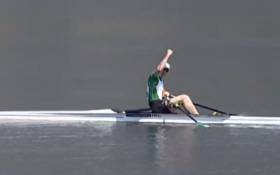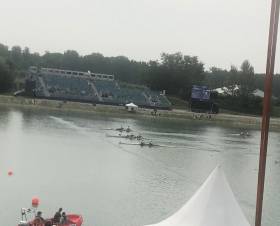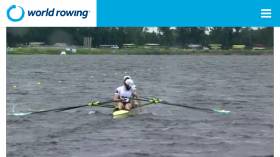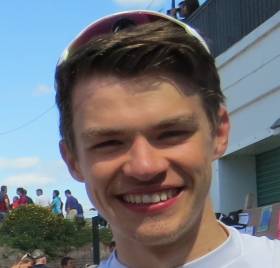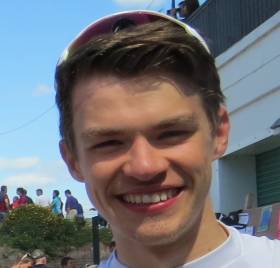Displaying items by tag: Fintan McCarthy
Paul O'Donovan, Fintan McCarthy and Sanita Puspure named Afloat Rowers of the Year
Ireland’s two world champion crews of 2019 are the Afloat Rowers of the Year. Sanita Puspure defended her title in the women’s single sculls, while Paul O’Donovan and Fintan McCarthy proved themselves the best lightweight double in the world.
Paul O’Donovan’s fortitude, ambition, self-belief and professionalism make him the best male rower to come out of Ireland and one of the greatest sportsmen. Teamed up with his brother, Gary O’Donovan, he led the country to its first Olympic rowing medal in 2016, and the two went on to win World Championship gold in the lightweight double in 2018.
The year 2019 was different. Gary broke a bone in his wrist early in the year and took months to recover. The competition for the doubles spot with Paul O’Donovan was hot: the picture above shows the winning triallists, Fintan McCarthy and Paul O’Donovan just after they crossed the line and secured the coveted gig. They competed in the final World Cup in Rotterdam: in an amazing race with Germany they were beaten for the gold by three hundredths of a second despite having stopped while Paul flipped Fintan’s errant stroke coach back into the boat.
The World Championship final was – astoundingly – even more dramatic. Paul O’Donovan scoffs at those who say his crews start slowly. The statistics generally back him up. But in Linz-Ottensheim, Paul and Fintan were two and a half seconds down on the field (just over a length) at 500 metres. Italy and Germany looked strong and in command ahead of them. Could the men in green come back and still be there at the end? Even knowing the outcome, the video is a thriller. Through the second quarter, the Ireland unit outpaces every other crew; by 1300 metres they have shot into the lead; they build on that advantage to win by the margin by which they were behind 1500 metres before. As Paul and Fintan chatted to media after the race, Italy’s Pietro Ruta – he of the flowing beard – lay sprawled and virtually motionless in the media area. Silver was his, but his crew had yielded to the all-conquering Irish.
The World Championships saw the Ireland women’s pair of Monika Dukarska and Aileen Crowley qualify the boat for the Olympics, the men’s double of Phil Doyle and Ronan Byrne sweep to silver, while Katie O’Brien took the bronze medal in the PR2 pararowing final.
 Sanita (left) with Sarah Jane McDonnell
Sanita (left) with Sarah Jane McDonnell
Sanita Puspure topped it all. A year in which her competition was curtailed as she spent time with her dying sister Inese became a year in which she showed what a wonderful, inspiring, athlete she can be. The women’s single sculls at the World Championships might well have been all about the comeback story of New Zealand’s Emma Twigg. Self-exiled in order to study, she had paid the price of falling away from competition. Fourth at the Olympic Games in 2016, she roared back in 2019 to win the World Cup regattas in Poznan, Poland and Rotterdam. In the World Championships semi-final, Twigg hung on to Puspure and took second; in the final she blasted out into the lead and held it till the final quarter, only to see Puspure flash past to win well. For Puspure it had been four races, four wins, four demonstrations of her command.
Sanita Puspure, Paul O’Donovan and Fintan McCarthy are the Afloat Rowers of the Year 2019.
Rower of the Year awards: The judging panel is made up of Liam Gorman, rowing correspondent of The Irish Times and David O'Brien, Editor of Afloat magazine. Monthly awards for achievements during the year 2020 will appear on afloat.ie. Keep a monthly eye on progress and watch our champions list grow.
Three Ireland Finalists for World Rowing Awards 2019
#Rowing: Ireland figure strongly in the finalists for the World Rowing Awards 2019. World champions Sanita Puspure, in the single sculls, and the lightweight double of Paul O’Donovan and Fintan McCarthy are finalists for women’s and men’s crews of the year. Ronan Byrne (21) is one of four finalists for the Filippi Spirit Award for outstanding university rower. Byrne won gold in the single sculls at the European Under-23 Championships just a week after partnering Philip Doyle to silver in the double sculls at the senior World Championships.
The award ceremony is on November 22nd in London.
Finalists for the 2019 World Rowing Awards
Thomas Keller Medal – for a rower who has had a long and successful rowing career and who has made an outstanding contribution to rowing as a competitor and as a sports personality.
- · Kim Brennan,Australia
- · Ekaterina Karsten,Belarus
- · James Cracknell,Great Britain
- · Pete Reed,Great Britain
- · Andrew Triggs Hodge,Great Britain
Filippi Spirit Award – for a university rower who has demonstrated the core values of rowing in his/her social, academic and sporting life and, through these values, also enabled or inspired exceptional success in other people's lives.
- · Ria Thompson,Australia
- · Jean Maillard,France
- · Ronan Byrne,Ireland
- · Nicholas Perovich,United States
World Rowing Sustainability Award – for an organisation that has implemented an innovative project or initiative delivering a clear and positive sustainability impact.
- · Spring Creek Regeneration Project,Australia
- · 2018 World Rowing Coastal Championships,Canada
- · Wintech: Clean air, water and solar power,China
- · Rowers Against Rubbish,Great Britain
- · Developing Environmental Ambassadors,Japan
World Rowing Para-rowing Crew of the Year
- · Kathryn Ross,Australia,Para PR2 Women’s Single Sculls
- · Ellen Buttrick, Giedre Rakauskaite, James Fox, Oliver Stanhope and Erin Wysocki-Jones (coxswain),Great Britain,Para PR3 Mixed Coxed Four
- · Lauren Rowles and Laurence Whiteley,Great Britain,Para PR2 Mixed Double Sculls
- · Birgit Skarstein,Norway,Para PR1 Women’s Single Sculls
- · Roman Polianskyi,Ukraine,Para PR1 Men’s Single Sculls
World Rowing Men’s Crew of the Year
- · Zhiyu Liu and Liang Zhang,China,Men’s Double Sculls
- · Valent Sinkovic and Martin Sinkovic,Croatia,Men’s Pair
- · Oliver Zeidler,Germany,Men’s Single Sculls
- · Paul O’Donovan and Fintan McCarthy,Ireland,Lightweight Men’s Double Sculls
- · Dirk Uittenbogaard, Abe Wiersma, Tone Wieten and Koen Metsmakers,The Netherlands,Men’s Quadruple Sculls
World Rowing Women’s Crew of the Year
- · Olympia Aldersey, Katrina Werry, Sarah Hawe and Lucy Stephan,Australia,Women’s Four
- · Yunxia Chen, Ling Zhang, Yang Lyu, Xiaotong Cui,China,Women’s Quadruple Sculls
- · Sanita Puspure,Ireland,Women’s Single Sculls
- · Zoe McBride and Jackie Kiddle,New Zealand,Lightweight Women’s Double Sculls
- · Grace Prendergast and Kerri Gowler,New Zealand,Women’s Pair
World Rowing Coach of the Year
- · Bernd Nennhaus,Germany,junior rowing crews
- · Tom Dyson,Great Britain,Para-rowing coach
- · Eelco Meenhorst,Netherlands,men’s sculling head coach
- · Gary Hay,New Zealand,women’s head coach
- · Johan Flodin,Norway,head coach
World Champions O'Donovan, McCarthy and Puspure are Rowers of the Month
#Rowing: The two crews which won gold for Ireland at the World Championships, the lightweight men’s double of Paul O’Donovan and Fintan McCarthy and single sculler Sanita Puspure, are the Afloat Rowers of the Month for August.
The month was quite extraordinary. The Ireland double of Philip Doyle and Ronan Byrne qualified their boat for Tokyo at the World Championships in Linz-Ottensheim and then went on to take silver with an assured, technically impressive, performance in a gripping final; the women’s pair of Aileen Crowley and Monika Dukarska secured qualification with second in their B Final, eighth overall, well within the 11 places allotted for Tokyo. Along with the two gold-medal boats, this brought the Ireland complement for the Olympic Games to four, a record in the era of boats having to qualify through set competition.
The Championships had also been a joyful one for Katie O’Brien. She took Ireland’s first medal, a bronze, in the PR2 single sculls on her 23rd birthday.
Ireland crews came up just short of podium finishes at the Coupe de la Jeunesse and the World Junior Championships. Back in Ireland, the two Coastal Rowing Championships generated fine entries and plenty of excitement.
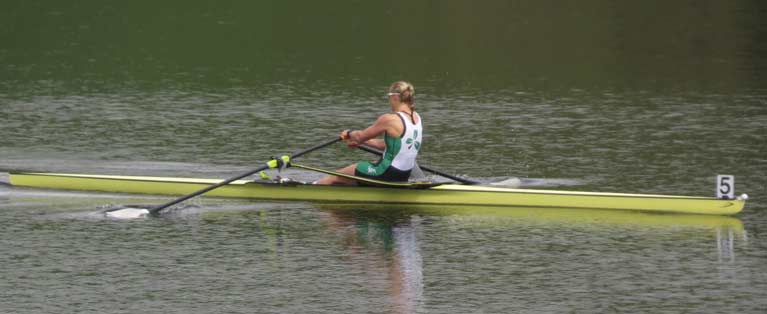 World champion Sanita Puspure in action Photo: Liam Gorman
World champion Sanita Puspure in action Photo: Liam Gorman
The pressure was on Sanita Puspure and the lightweight double in Austria. Puspure’s year was affected by family bereavement. She was defending a title in a keenly-contested category. Looking back, her achievement can seem pre-ordained – it was not. She won her early races by big margins, consigning former Olympic champion Mirka Topinkova Knapkova to a distant second in her quarter-final. And then came the semi-final. Emma Twigg of New Zealand had made no secret of her ambition of ousting her friend from her eminent position. Puspure never let her get the chance, outpacing her in each of the four quarters. The final, on September 1st, would see Twigg try to win from the front. It was desperate stuff, and Puspure, knowing she had the resources to do it, waited her out and rowed through her.
Nominally, the Ireland lightweight double were defending their title. But this was a new combination, with Fintan McCarthy coming in to partner Paul O’Donovan. The finish of their semi-final was nail-biting, as three boats (Ireland, Germany, Norway) were covered by .69 of a second. In the final the feeling of jeopardy lasted the whole race. Ireland had a poor first quarter, which left them trailing the field, produced a ridiculously good middle thousand in which they passed Germany and Italy, and then gritted it out to take a clearwater win. The exhaustion – physical, mental – of the second-placed Italy crew of Pietro Ruta and Stefano Oppo after the race was affecting. They looked like they could not process what had happened to them.
Rower of the Month awards: The judging panel is made up of Liam Gorman, rowing correspondent of The Irish Times and David O'Brien, Editor of Afloat magazine. Monthly awards for achievements during the year will appear on afloat.ie. Keep a monthly eye on progress and watch our 2019 champions list grow.
McCarthy and O'Donovan Speed Past Opponents to Win Gold
#Rowing: Paul O'Donovan and Fintan McCarthy became the world champions in the lightweight double sculls with an outstanding victory over Germany and Italy here in Linz-Ottensheim.
The men in blue and red and white disputed the lead through the first quarter of the race, with Ireland a length behind in sixth. From there O'Donovan and McCarthy put the foot down. They set the fastest time for the next three quarters, accelerating into the headwind and clawing their way to level and then past their two big rivals.
They kept going right to the end and beat the Italians by just over a length, with Germany taking the bronze.
World Rowing Championshiops, Linz-Ottensheim, Day Seven (Irish interest)
Men
Lightweight Double - A Final: 1 Ireland (F McCarthy, P O'Donovan) 6:37.28, 2 Italy 6:39.71, 3 Germany 6:41.07.
Women
Four - B Final (First Two book Olympic places for boat): 1 Britain 6:55.08, 2 Canada 6:56.99; 3 China 7:02.28, 4 Ireland Ireland (T Hanlon, E Lambe, A Keogh, E Hegarty) 7:02.71.
Pair - B Final (First Five book Olympic places for boat): 1 Romania 7:18.88, 2 Ireland (A Crowley, M Dukarska) 7:20.68.
Lightweight Double Sculls - C Final (Places 13 to 18) 1 China 7:00.82; 5 Ireland (A Casey, D Walsh) 7:10.52.
Thrilling Semi-Final Win By O'Donovan and McCarthy Sends Ireland Boat to Olympic Games
#Rowing: Ireland's first boat qualified for the 2020 Olympic Games is the lightweight men's double. Fintan McCarthy and Paul O'Donovan won in a thrilling semi-final here in Linz-Ottensmeim to take an A Final place at the World Championships and land a berth for the boat in Tokyo.
This was classic Paul O'Donovan. He gelled with his new partner, McCarthy, to produce a perfectly-judged finish which pushed Germany into second - by 13 hundredths of a second. Norway, like Ireland, had watched Germany and Australia do the early work, then closed on them in the final stages. The Norway crew of Are Strandli and Kris Brun, who were bronze medallists behind Ireland's silver in Rio 2016, produced the fastest finish of all to take third. Australia fell back to fifth.
All six A Finalists and the eventual winner of the B Final qualify boats for Tokyo 2020.
The Ireland women's pair of Aileen Crowley and Monika Dukarska will have to make their way through the B Final (placing fifth or better) if they are to qualify the boat for the Olympics. They finished fourth in a hotly-contested semi-final. New Zealand won with a commanding performance; the United States forced their way into second; the battle was joined between Ireland and fast-finishing Italy, who took the crucial third place.
World Rowing Championships, Linz-Ottensheim, Austria - Day Five (Irish interest)
Men
Lightweight Double Sculls - A/B Semi-Final Two (First Three to A Final; rest to B Final): 1 Ireland (F McCarthy, P O'Donovan) 6:13.46, 2 Germany 6:13.59, 3 Norway 6:14.15.
Women
Pair - A/B Semi-Final Two (First Three to A Final; rest to B Final): 1 New Zealand 6:57.92, 2 United States 7:01.78, 3 Italy 7:01.80; 4 Ireland (A Crowley, M Dukarska) 7:03.05.
O'Donovan and McCarthy Win Way to World Semi-Finals
#Rowing: It was tight at the finish, but Paul O'Donovan and Fintan McCarthy qualified for the semi-finals of the lightweight double sculls at the World Championships with a win here in Linz-Ottensheim. Spain held the lead through much of this quarter-final, but Ireland were poised to take them and did in the final quarter. Poland took third.
The women's lightweight double dropped out of the running for a top-three place early on, but kept fighting to the line. They beat Poland in a battle for fourth. They will compete in the C/D Semi-Finals.
World Rowing Championships, Linz-Ottensheim, Austria, Day Four (Irish interest)
Men
Lightweight Double Sculls - Quarter-Final Three - (First Three to A/B Semi-Finals; rest to C/D Semi-Finals): 1 Ireland (F McCarthy, P O'Donovan) 6:20.84, 2 Spain 6:22.84, 3 Poland 6:23.72.
Women
Pair - Quarter-Final Two (First Three to A/B Semi-Finals; rest to C/D Semi-Finals): 1 Australia 7:08.74, 2 Ireland (A Crowley, M Dukarska) 7:12.51, 3 Italy 7:13.11.
Lightweight Double Sculls - Quarter-Final Three - (First Three to A/B Semi-Finals; rest to C/D Semi-Finals): 4 Ireland (A Casey, D Walsh) 7:07.17.
Pararowing: Women's PR Two Single Sculls, Preliminary Race: 1 Australia (K Ross) 9:24.99; 3 Ireland (K O'Brien) 9:52.13.
#Rowing: Ireland’s Fintan McCarthy and Paul O’Donovan won their heat to qualify directly for their quarter-final of the lightweight double sculls at the World Rowing Championships in Austria this morning. The Skibbereen-UCC combination were well in command all through. There was a big surprise in the previous heat. Norway, who took bronze at the Rio Olympics, did not make it directly to the quarter-finals. They were fourth.
World Rowing Championships, Linz, Austria, Day One (Irish interest)
Men
Pair – Heat One (First Four to Quarter-Finals; rest to Repechage): 6 Ireland (M O’Donovan, S O’Driscoll) 6:50.51.
Lightweight Double Sculls – Heat Three (First Three to Quarter-Finals; rest to Repechage): 1 Ireland (F McCarthy, P O’Donovan) 6:28.02
Women
Pair – Heat Four (First Four to Quarter-Finals; rest to Repechage): 2 Ireland (A Crowley, M Dukarska) 7:13.30
#Rowing: Paul O'Donovan and Fintan McCarthy took a second silver medal for Ireland after an extraordinary final of the lightweight double sculls at the World Cup in Rotterdam today.
Ireland took over the lead early and led all the way until they were caught right on the line by Germany - the photo finish showed just .03 of a second between the crews.
The race had a memorable moment in the second quarter. Paul O'Donovan showed great calmness to reach down and grab what looked like the stroke coach of the bowman which had gone over the side to shuck it back in the boat. The incident may have cost the crew time, but they retained their lead from there to the line.
Ronan Byrne and Philip Doyle had earlier sculled really well to take silver in the men's openweight double sculls.
World Cup Regatta, Rotterdam, Day Three (Irish interest)
Men
Double Sculls - A Final: 1 Switzerland 6:41.04, 2 Ireland (P Doyle, R Byrne) 6:41.74, 3 Britain 6:44.95.
Lightweight Double Sculls - A Final: 1 Germany 7:01.59, 2 Ireland (F McCarthy, P O'Donovan) 7:01.62, 3 Norway 7:02.26.
Women
Pair - A Final: 1 Australia 7:26.15, 2 New Zealand 7:27.57, 3 Britain 7:40.51; Ireland (A Crowley, M Dukarska) 7:50.08.
Lightweight Double Sculls - B Final (places 7 to 12): 6 Ireland (L Heaphy, D Walsh) 7:45.98.
#Rowing: Paul O'Donovan and Fintan McCarthy brought the tally of Ireland A Finalists at the World Cup Regatta in Rotterdam to four with a second-placed finish in their semi-final. Germany's Jason Osborne and Jonathan Rommelmann, racing in the favoured lane one were the dominant crew, but the new Ireland lightweight double finished fast, coming to just about a length on the line.
The Ireland women's lightweight double were out in lane six in the revised lane draw in their semi and finished sixth. Lydia Heaphy and Denise Walsh are set for a B Final.
World Cup Regatta, Rotterdam, Day Two (Irish interest; morning session)
Men
Double Sculls - Semi-Final Two (First Three to A Final; rest to B Final): 1 Ireland (P Doyle, R Byrne) 6:33.47, 2 Germany 6:36.17, 3 Australia One 6:38.62
Lightweight Double Sculls - Semi-Final Two (First Three to A Final; rest to B Final): 1 Germany One 6:42.04, 2 Ireland (F McCarthy, P O'Donovan) 6:43.70, 3 Australia 6:50.80.
Lightweight Single Sculls - Semi-Final Two (First Three to A Final; rest to B Final): 1 Slovenia 7:22.30, 2 3 Ireland One (G O'Donovan) 7:25.89, 3 Switzerland 7:27.70; 4 Ireland Two (J McCarthy) 7:34.79.
Women
Pair - Semi-Final One (First Three to A Final; rest to B Final): 1 Romania One 7:34.61, 2 Ireland (A Crowley, M Dukarska) 7:37.87, 3 Spain 7:39.49.
Lightweight Double Sculls - Semi-Final Two (First Three to A Final; rest to B Final): 6 Ireland (L Heaphy, D Walsh) 7:49.87.
#Rowing: Paul O’Donovan will team up with Fintan McCarthy in the lightweight double at the World Cup Regatta in Rotterdam, the Netherlands, from July 12th to 14th. Gary O’Donovan and Jake McCarthy will compete in lightweight singles.
World and European champion Sanita Puspure will hope to continue her winning run in the single. Monika Dukarska and Aileen Crowley form a pair and Denise Walsh and Lydia Heaphy will compete again in the lightweight double, as will Ronan Byrne and Philip Doyle in the men’s openweight double.
Ireland Crews for World Rowing Cup Three, Rotterdam, July 12th to 14th
Men
Double: R Byrne, P Doyle
Lightweight Double: F McCarthy, P O’Donovan
Lightweight Singles: G O’Donovan; J McCarthy
Women
Pair: M Dukarska, A Crowley
Single: S Puspure
Lightweight Double: D Walsh, L Heaphy



























